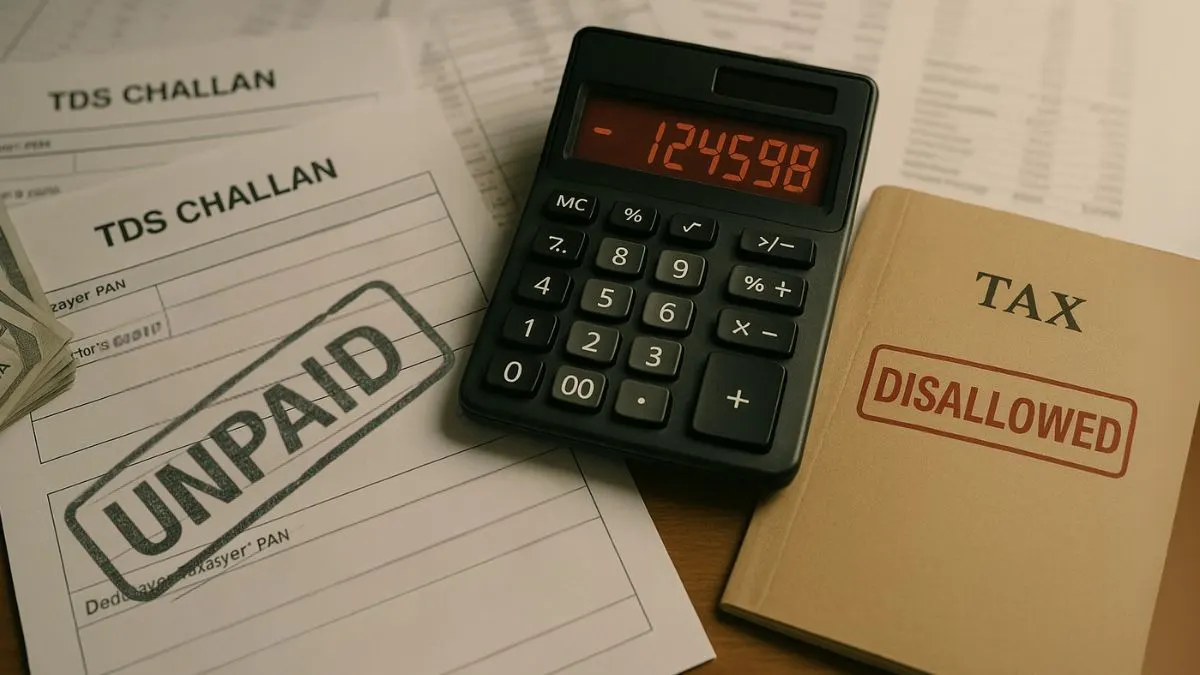
Every taxpayer knows that business expenses reduce taxable income, but not all expenses are eligible for deduction. The Income Tax Act, 1961 has clear provisions where certain expenses cannot be claimed, even if they are genuine business costs. One of the most important rules in this context is Section 40(a).
This section specifically deals with expenses or payments not deductible in certain circumstances. In simple terms, if a business does not comply with rules related to TDS (Tax Deducted at Source) or makes certain payments in cash, the expenditure will be disallowed. By doing so, Section 40(a) discourages businesses from making large cash payments & strengthens the monitoring of transactions.
Understanding Section 40(a)
Section 40 falls under the broader framework of computation of business or professional income. While business owners can normally deduct expenses incurred for generating income, Section 40(a) creates a list of amounts not deductible.
These include:
- Payments made outside India or to non-residents without TDS.
- Payments to residents where TDS was not deducted or not deposited within due dates.
- Certain large cash transactions.
Thus, Section 40(a) ensures tax authorities can track payments & prevent tax evasion."
Key Provisions of Section 40(a)
- Non-Resident Payments – Section 40(a)(i)
Any interest, royalty, fees for technical services, or other sums chargeable under the Act that are payable outside India or to a non-resident, are disallowed if TDS is not deducted or deposited.
Example: A company paying royalty to a foreign entity must deduct tax under Section 195. If it fails to do so, the entire expense will be disallowed.
- Resident Payments – Section 40(a)(ia)
For payments made to residents, like contractors, rent, commission, professional fees, etc., 30% of the expense will be disallowed if:
- TDS is not deducted, or
- TDS is deducted but not deposited before the due date of filing ITR.
This provision puts strict responsibility on businesses to comply with TDS laws.
- Disallowance of Cash Payments – Section 40A(3)
Although separate from Section 40(a), Section 40A(3) complements it by discouraging large cash transactions. Any expenditure above ₹10,000 made in cash (₹35,000 in case of transporters) is disallowed. The idea is to promote banking transactions and curb black money.
Why These Expenses Are Disallowed
The central idea behind Section 40(a) is compliance. The Income Tax Department ensures that payments are routed through proper channels & tax is collected in advance wherever applicable.
By marking such expenses or payments not deductible in certain circumstances, the law ensures:
- Businesses follow TDS rules.
- Tax revenue is not lost.
- Cash transactions are minimized.
- Transparency in accounting is maintained.
Also Read: Understanding Disallowances on Expenses and Payments
Practical Examples
Example 1: TDS Not Deducted
A company pays ₹5,00,000 to a contractor but forgets to deduct TDS. As per Section 40(a)(ia), 30% of this expense (₹1,50,000) will be disallowed.
Example 2: TDS Deducted but Not Deposited
A business deducts TDS of ₹50,000 on rent but deposits it after the due date of filing return. This expense too will be disallowed until the TDS is deposited.
Example 3: Large Cash Payment
An enterprise purchases raw material worth ₹1,20,000 in cash. As per Section 40A(3), the entire expense is disallowed, since it exceeds the ₹10,000 limit.
Exceptions to Disallowance
The law also provides relief in genuine cases. For example:
- Payments made in rural areas with no banking facilities.
- Payments to government agencies.
- Transactions where cash is unavoidable due to business circumstances.
Thus, while Section 40(a) & related provisions are strict, they are not unreasonable.
Impact on Businesses
For businesses, non-compliance with Section 40(a) leads to:
- Higher taxable income (due to disallowed expenses).
- Additional tax outflow.
- Possible penalties and interest for TDS defaults.
Therefore, Section 40(a) serves as a reminder that amounts not deductible are not just a loss of deduction but also increase compliance costs.
Section 40(a) vs. Section 40A(3)
Many taxpayers confuse the two, but they deal with different issues:
- Section 40(a): Focuses on TDS compliance.
- Section 40A(3): Focuses on restricting large cash payments.
Both sections work together to ensure tax compliance & discourage cash dealings.
Also Read: A Hidden Provision That Can Save or Sink Your Tax Planning
Why Section 40(a) Matters Today
In today’s digital era, where tax authorities track real-time payments through TDS and GST, Section 40(a) of the Income Tax Act becomes even more significant. With stricter data-sharing between banks and the Income Tax Department, businesses cannot afford to overlook compliance.
Moreover, disallowance of expenses directly increases tax liability, affecting profitability."
Conclusion
Section 40(a) of the Income Tax Act is a powerful compliance tool in India’s tax framework. By listing expenses or payments not deductible in certain circumstances, it ensures that businesses follow TDS rules and avoid large cash payments. The ultimate aim is to create transparency, curb tax evasion, and promote a digital, accountable economy.
For business owners, the takeaway is simple: Always deduct & deposit TDS on time and avoid cash payments beyond the permitted limits. Doing so not only saves tax but also prevents unnecessary disputes with the tax department.
👉 Want to avoid disallowances under Section 40(a) and keep your business tax-efficient? Get expert assistance at Callmyca.com – your trusted partner in compliance and tax advisory.











